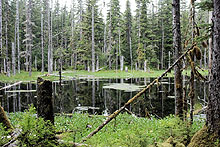What Is a Bog?

A bog in Alaska
|
A bog, quagmire or mire is a wetland type that accumulates acidic peat, a deposit of dead plant material — usually mosses, but also lichens in Arctic climates.
Bogs occur where the water at the ground surface is acidic, either from acidic ground water, or where water is derived entirely from precipitation, when they are termed ombrotrophic (rain-fed). Water flowing out of bogs has a characteristic brown color, from dissolved peat tannins. Bogs are very sensitive habitats, of high importance for biodiversity.
Bogs are widely distributed in cold, temperate climes, mostly in the northern hemisphere (boreal). The world's largest wetlands are the bogs of the Western Siberian Lowlands in Russia, which cover more than 600,000 square kilometres. Sphagnum bogs were widespread in northern Europe: Ireland was more than 15% bog (Achill Island off Ireland is 87% bog), Scotland, Denmark, Estonia (20% bog lands), Finland (26%), northern Germany, Latvia (10%), the Netherlands, Norway and Sweden. There are extensive bogs in Canada and Alaska (called muskeg). There are also bogs in Patagonia and the Falkland Islands in the southern hemisphere. Ombrotrophic wetlands (of which bogs are an example) are also found in the tropics, with notable areas documented in Kalimantan; these habitats are forested so would be better called acidic swamps.
|